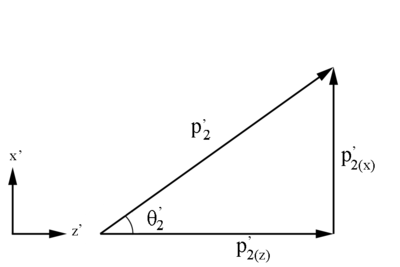Difference between revisions of "Final Lab Frame Moller Electron 4-momentum components in XZ Plane"
Jump to navigation
Jump to search

Figure 3: Definition of Moller electron variables in the Lab Frame in the x-z plane.
Using
should always be positive with respect to the total momentum. This is effectively a ratio of momentum in the z direction versus total momentum.
| Line 20: | Line 20: | ||
| + | |||
| + | |||
| + | |||
| + | |||
| + | Since, | ||
| + | <center><math>\frac{p^'_{2(z)}}{p^'_{2}}=cos(\theta '_2)</math></center> | ||
| + | |||
| + | |||
| + | <center><math>\Longrightarrow p^'_{2(z)}</math> should always be positive with respect to the total momentum. This is effectively a ratio of momentum in the z direction versus total momentum. </center> | ||
| Line 28: | Line 37: | ||
|} | |} | ||
| − | + | At <math>\theta=0^{\circ} \quad \cos{0}=1 \Rightarrow p=p_z</math> and all motion is in the z direction. | |
| − | |||
| − | + | At <math>\theta=90^{\circ} \quad \cos{90}=0 \Rightarrow p=\sqrt{p_x^2+p_y^2}</math> The motion is in the x-y plane. | |
Revision as of 02:07, 16 June 2017
Final Lab Frame Moller Electron 4-momentum components in XZ Plane

Since,
Checking on the sign resulting from the cosine function, we are limited to:
At and all motion is in the z direction.
At The motion is in the x-y plane.